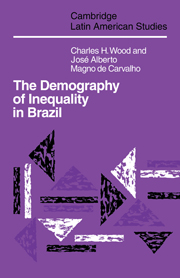Book contents
- Frontmatter
- Contents
- Illustrations
- List of tables
- Preface
- 1 Introduction
- 2 Framework for the study of population, development and inequality
- 3 Growth and distribution in historical perspective
- 4 Income inequality and length of life
- 5 Wage policy, infant mortality and collective social action in São Paulo
- 6 Racial inequality and child mortality
- 7 The “baby bust”
- 8 Income distribution and population growth
- 9 Agrarian structure and the rural exodus
- 10 Colonization and frontier expansion in Amazônia
- 11 Development and persistent underemployment
- 12 The demography of inequality in Brazil: summary and conclusion
- Appendix: A note on method
- Notes
- Bibliography
- Index
- CAMBRIDGE LATIN AMERICAN STUDIES
10 - Colonization and frontier expansion in Amazônia
Published online by Cambridge University Press: 04 August 2010
- Frontmatter
- Contents
- Illustrations
- List of tables
- Preface
- 1 Introduction
- 2 Framework for the study of population, development and inequality
- 3 Growth and distribution in historical perspective
- 4 Income inequality and length of life
- 5 Wage policy, infant mortality and collective social action in São Paulo
- 6 Racial inequality and child mortality
- 7 The “baby bust”
- 8 Income distribution and population growth
- 9 Agrarian structure and the rural exodus
- 10 Colonization and frontier expansion in Amazônia
- 11 Development and persistent underemployment
- 12 The demography of inequality in Brazil: summary and conclusion
- Appendix: A note on method
- Notes
- Bibliography
- Index
- CAMBRIDGE LATIN AMERICAN STUDIES
Summary
In the 1970s, population movement became a major policy concern in Brazil. Rural to urban migration and the heavy interregional flow of people from the Northeast into cities in the Center-south increasingly strained the capacity of metropolitan areas to absorb population. The city of Sao Paulo, which already held over 10 million residents in 1970, continued to grow at an alarming rate, as did Rio de Janeiro and Belo Horizonte. To counter the increasing size and density of the urban population in industrialized regions, the government launched a plan to redirect the flow of migrants away from the south and into the sparsely populated Amazon. The Transamazon Highway and a public colonization project were cornerstones of the ambitious development scheme that began with the National Integration Plan in 1970.
In view of the vast expanse of relatively uninhabited territory in the tropical lowlands of northern Brazil, the move to occupy Amazonia presented a seemingly plausible solution to the maldistribution of population. For the military regime, the plan was also politically compelling. The colonization of new lands addressed the conditions of the rural poor yet sidestepped the issue of land redistribution in the old established regions of the country. Moreover, by portraying colonization as a geopolitical necessity that would protect Brazil's vulnerable interior from foreign encroachment, the regime identified itself with a longstanding nationalist theme. Aside from what may be politically expedient, is the opening of Amazonia a realistic solution to population pressure and rural poverty?
- Type
- Chapter
- Information
- The Demography of Inequality in Brazil , pp. 221 - 236Publisher: Cambridge University PressPrint publication year: 1988
- 1
- Cited by



